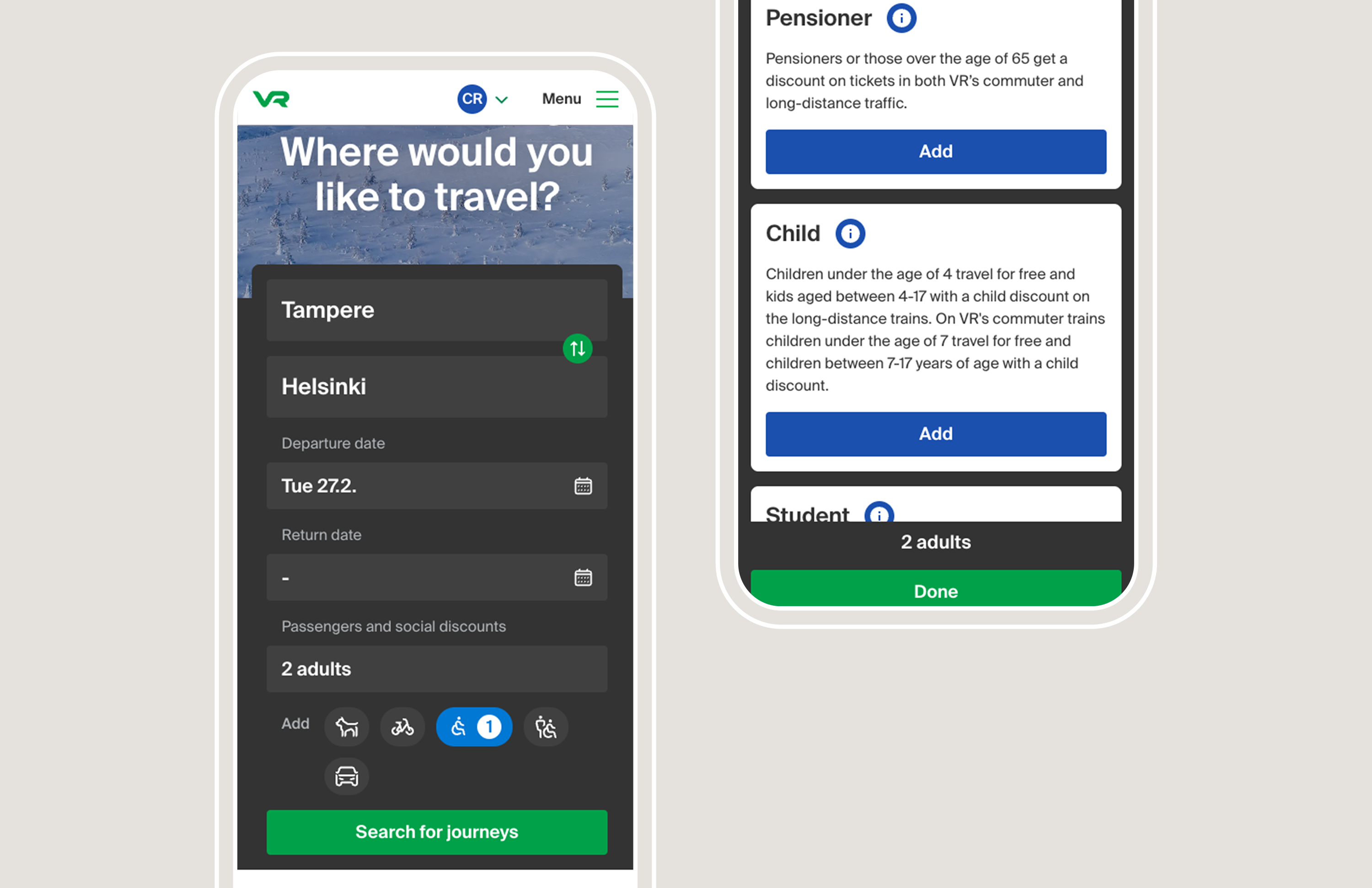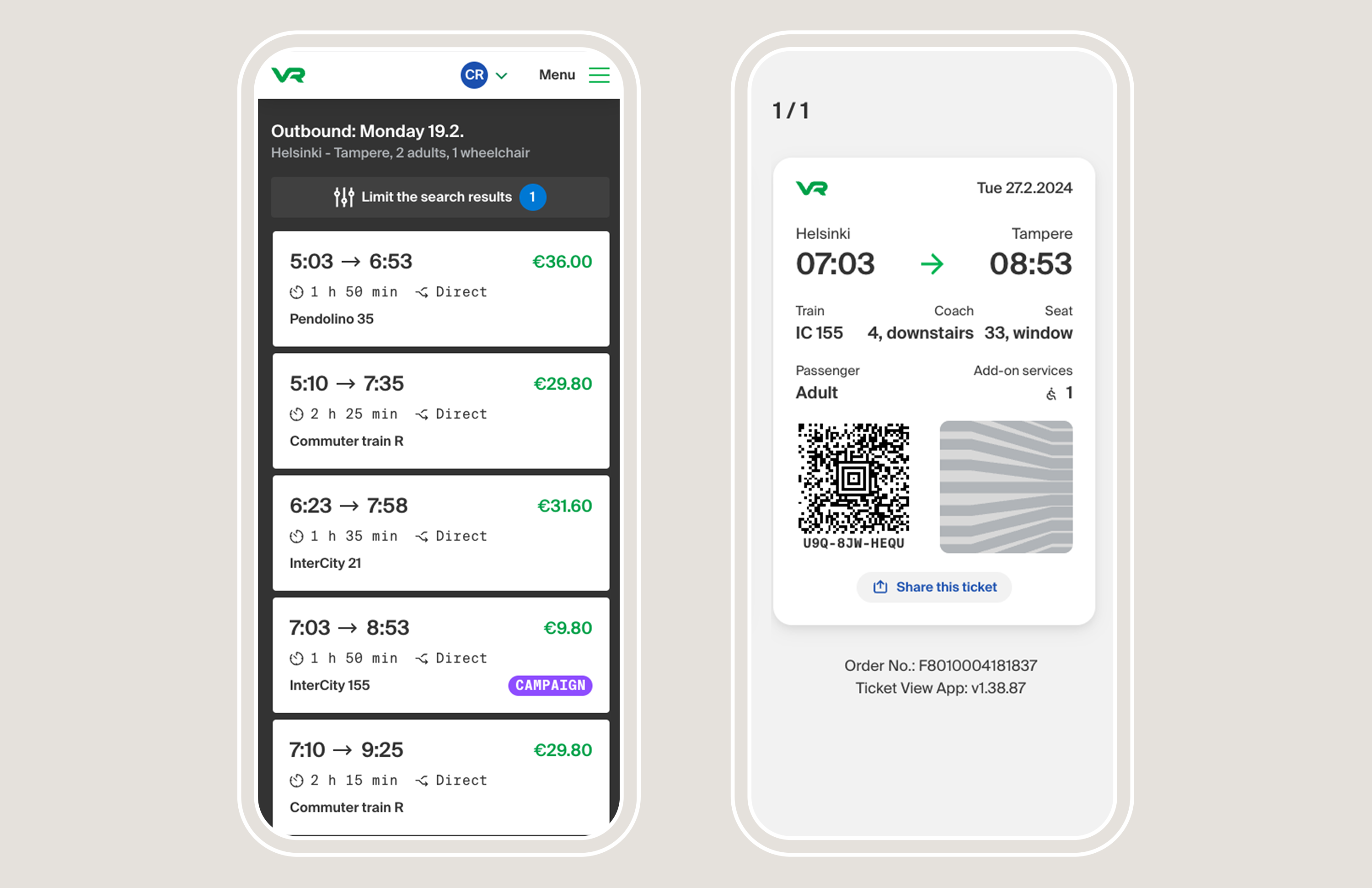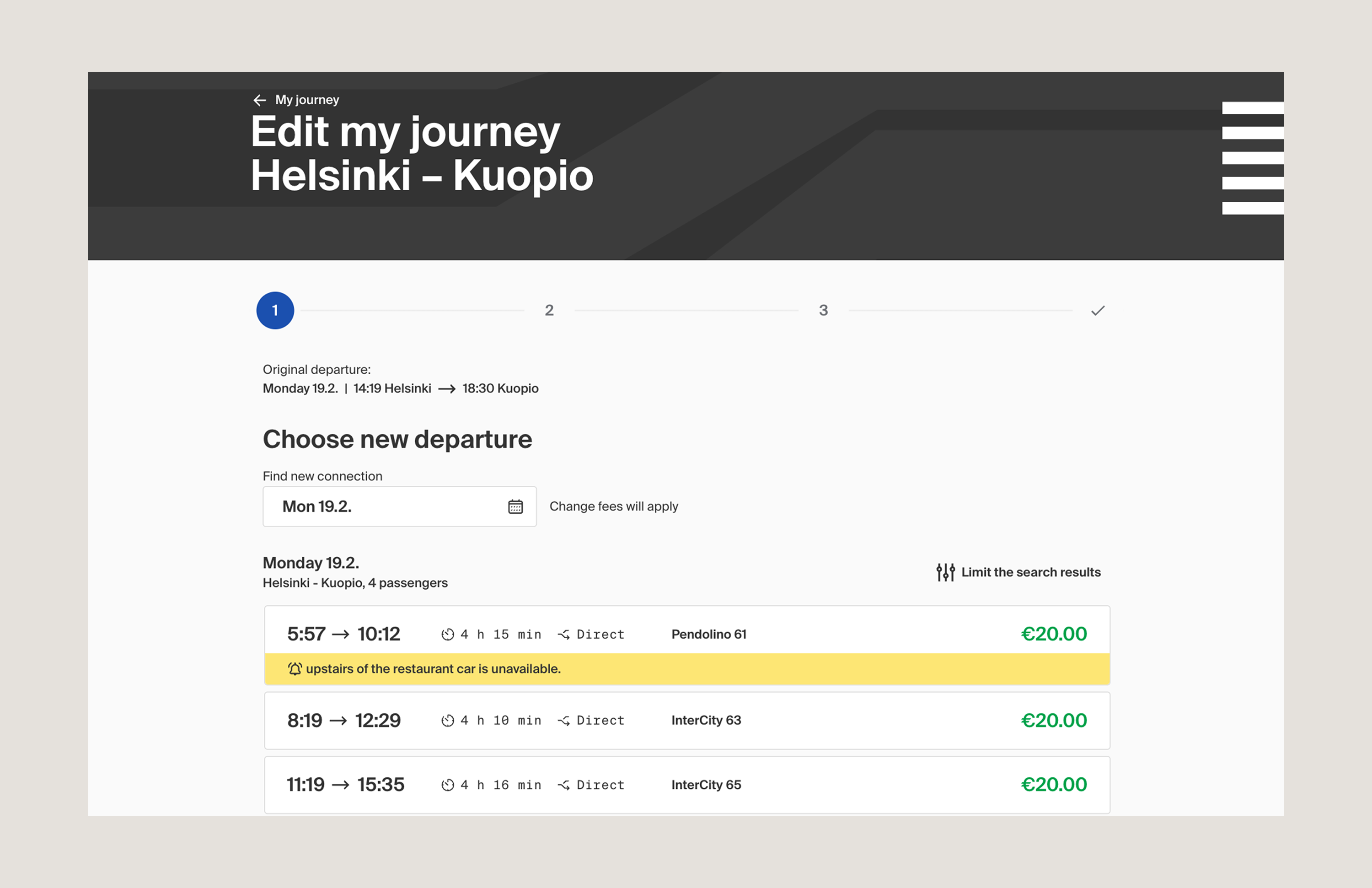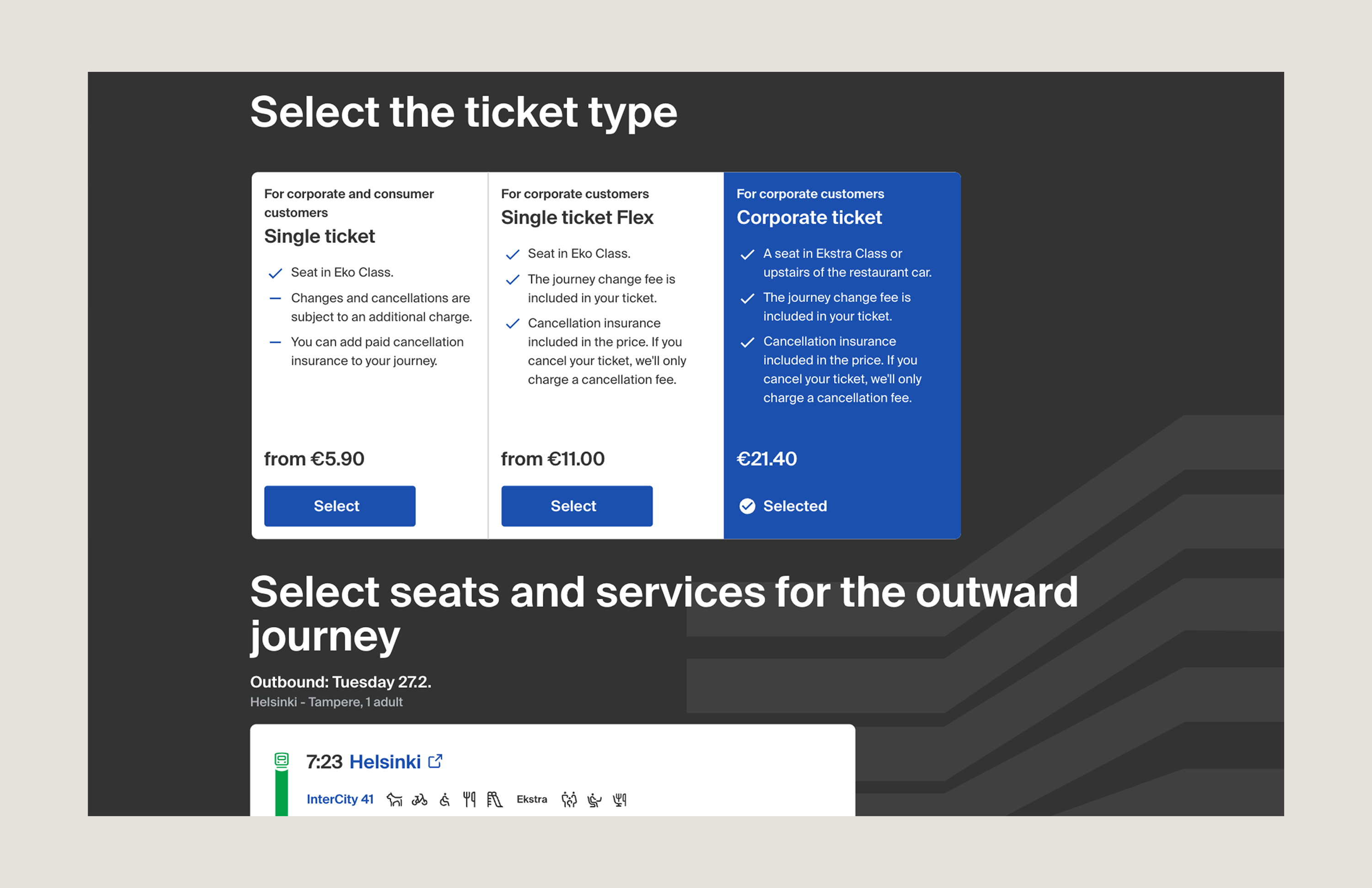VR Group
VR Group is a diversified, environmentally friendly and responsible service company operating in the field of travel and logistics. VR Group is owned entirely by the Finnish state.
WebsiteFor more than two years, Columbia Road has been supporting VR in enhancing digital sales through their web channel. Our dedicated UX/UI design team has supported VR in framing and resolving VR’s customer needs.
With 160 years of experience VR Group promotes responsible transport of the future. VR is a passenger, logistics and maintenance service company owned by the Finnish state, and VR increases the popularity of carbon-neutral rail and city traffic. VR ensures smooth daily travel in Finland and Sweden and acts as a pillar of support for the logistics industry in Finland. In 2022, VR's customers made a total of 194.2 million journeys and transported 34.4 million tonnes of goods.
VR’s passenger travel ticket channels are truly omnichannel, the biggest core channels being vr.fi and VR Matkalla mobile application. Besides core channels, VR is supported by a customer service sales system and third-party sales through R-kioskis and travel agencies, as well as physical support channels such as vending machines and ticket sales offices in two of the biggest cities of Finland.
"What has been most important is Columbia Road's ability to understand both our customer experience goals and business needs together with our technical capabilities – as designers drive improvement in our digital CX, it's very important they do it with knowledge of different angles we have to keep in mind.”
Amanda Kailio, Head of CX and Service Design at VR
Our team of UI/UX designers have been supporting VR’s core web channel, vr.fi, for over two years. As a key part of VR’s omnichannel sales, UX/UI design has a crucial role in creating a unified customer experience for all users who purchase train tickets and other services during their journey with VR. Vr.fi’s purpose is to act as the first step in fulfilling customer needs and providing engagement and inspiration for travelling.
Our work at VR's web team includes asking the right questions, identifying key problems, envisioning concrete solutions to customer needs, crafting them, testing them and ensuring successful implementation.
"Columbia Road’s designers have successfully navigated complex systems, business rules and edge cases. Their seamless collaboration with the team and other stakeholders has been instrumental. This synergy has elevated our ticket-selling experience to the next level."
Jan Rosnell, Design Lead at VR
Customer-centric design process ensures seamless experiences
VR leads its product development and design processes, and the approach entails mapping desirability, viability and feasibility together. From our point of view, this involves understanding the business logic, aligning UX/UI design based on technical capabilities, and comprehending user needs every step of the way.
VR’s customers are eagerly co-participating in the process from early planning to post-execution analyses. This is one of the best parts of working with VR, they have the most engaged customers as they receive constant feedback on a daily basis, helping us to plan services with customers first.
Amanda Kailio, Head of CX and Service Design at VR, describes the collaboration: “I have worked with Columbia Road for years now and have always been most happy with their forward-minded thinking and can-do attitude. A few years ago, as our design team was regrouping, we ended up finding our design talents from Columbia Road, and it strengthened our vision of a more seamless CX in each and every customer channel. What has been most important is their ability to understand both our customer experience goals and business needs together with our technical capabilities – as designers drive improvement in our digital CX, it's very important they do it with knowledge of different angles we have to keep in mind.”
Achieving joint success has only been possible by engagement and working together from start to finish throughout the entire design process. We have crafted each new feature by surrounding ourselves with a changing and dynamic team of specialists, including channel lead, service and business designers, business owners, back-end specialists, front-end specialists, copywriters, analysts, and quality assurance specialists. Delivering a seamless experience requires collaborative teamwork.
Before diving deep into the design of a new feature, we collaborate with business designers who have analysed the feature from a customer's perspective and form a comprehensive vision to guide the UX/UI design process forward. We also work with other channels' UX/UI designers to learn from their experiences and learnings from implementing similar features. We map out processes, examining how the logic of the feature influences both past and future features to ensure a seamless and continuous user experience.


Designing for a diverse range of customers
Introducing a new feature poses unique challenges, whether it involves redefining behaviours or enhancing existing experiences. For VR, one of the key focuses with their new services has been accessibility, as their services are used by such a broad range of customers. Our goal is to provide all users with good service, regardless of the device they use, taking into account screen readers and keyboard-assisted navigation.
When designing these features, we must consider the entire customer journey, encompassing stages such as getting to the station, purchasing train tickets, after-purchase edits, delivery or service use in the physical environment. In the context of VR, serving a diverse range of customers' needs across various channels introduces an added layer of complexity. Ensuring that the new features align with the overall VR channel look and feel while being specifically tailored to the web users is a crucial aspect of the process.
For testing and analysing our work throughout the journey, we use various qualitative and quantitative tools to ensure that new features are welcome. For instance, we test minor improvements through A/B tests with our growth hacking team for online testing and use live focus group interviews to help understand customer behaviour better. VR also has a lively customer online platform, where we can easily plan and implement UX/UI prototype tests for eager VR customers who are always interested in what happens next.


UX/UI design impact and achievements
VR has been leading us to joint success for the last couple of years, and we have gathered some highlights of our journey so far.
From tickets to ancillaries to door-to-door services
We have further adapted ancillary products to meet, for example, new needs arising from COVID-19 restrictions. This includes introducing adjacent seats and leveraging insights from traveller’s habits. We have tailored the offering to ensure that upgrades are only displayed if available to the entire party. Users can effortlessly upgrade to other ancillaries by clicking a single button outside the wagon map. Additionally, users can compare options and price differences between seat upgrades and cabins.
"You have had a remarkable impact on our digital channel development and user experience improvements. Happier customers and happier VR Group."
Matti Viljakainen, Channel Lead at VR
Customership
While we cater to the needs of both anonymous and logged-in users who purchase tickets via vr.fi, self-service edits are exclusively available for logged-in users. We have played a crucial role in supporting VR in their need to increase the percentage of order changes through self-service channels as opposed to relying on customer support. This has been achieved by expanding the capabilities of self-service edits after purchase.
Corporate sales and group sales renewal
Our contributions include the development of new services for B2B users, including corporate products, a modernised administrative interface, and a newly improved Customer Identity and Access Management (CIAM). Notably, the B2B interface received its first update in a decade.
We have also enabled travel agencies to purchase tickets for their clients by providing the option to choose between the consumer purchase funnel and the corporate purchase funnel. Additionally, we have customised customer profiles to meet their specific needs.
We have also introduced a group sales funnel form to facilitate a seamless transition with customer service, thereby reducing the need for extensive back-and-forth communication via email with potential customers.
Enabling better-targeted offering
We enabled the sales team to implement campaigns and targeted discounts on specific ancillary products both within the purchase funnel and during self-service edits after purchase. This grants the marketing team full ownership, enabling them to autonomously and efficiently automate campaigns at various stages of the customer's journey.

Key Achievements
- Over two years of close collaboration
- Over 30 successful features implemented
- Significantly exceeding ancillary sales
- Increased self-service share
The Data Handbook
How to use data to improve your customer journey and get better business outcomes in digital sales. Interviews, use cases, and deep-dives.
Get the book


